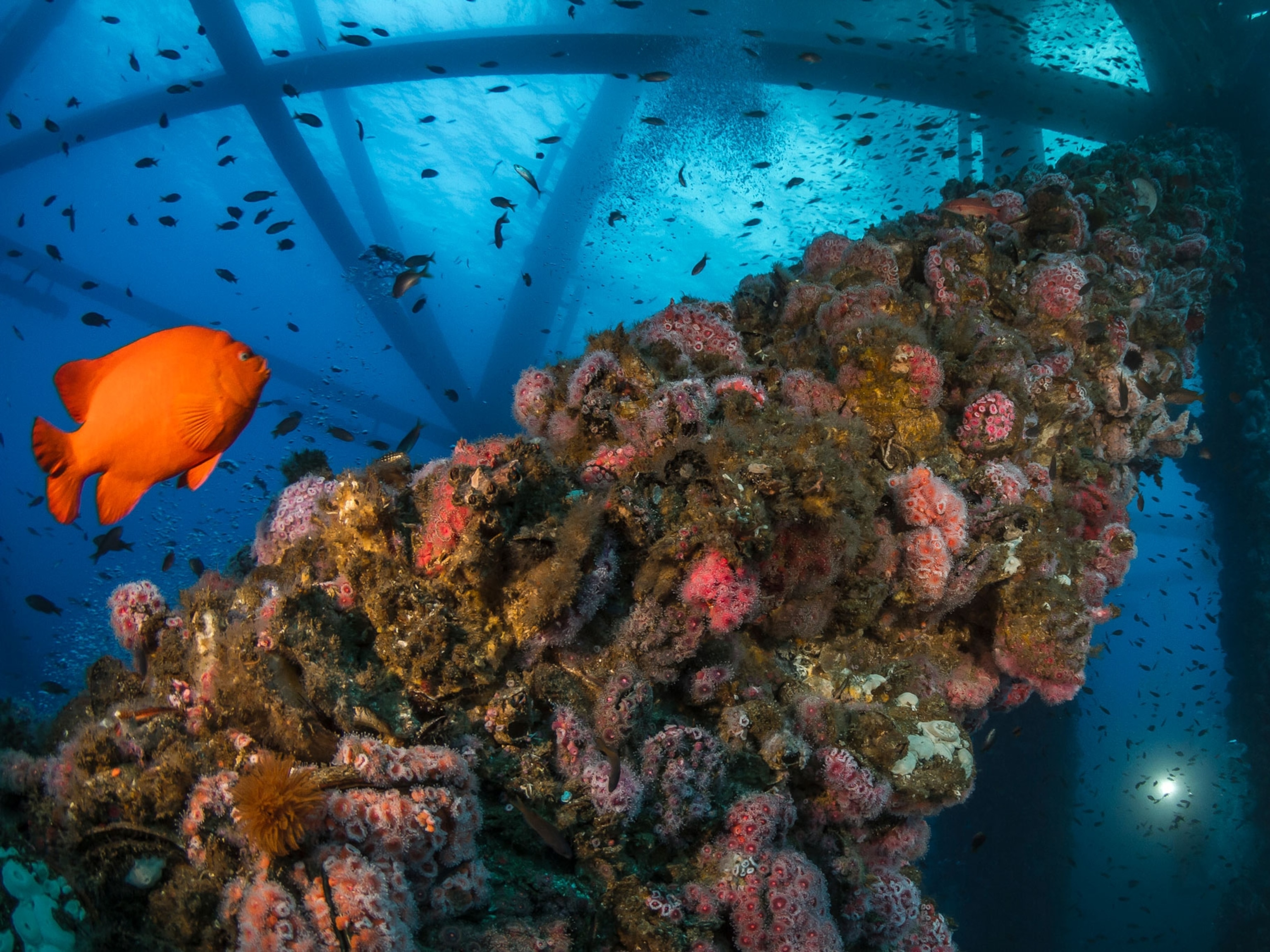
Where Currents Collide: The Marine Life of Vancouver Island
It seems insane to dive here. But it's the only way to witness the energy packed by some of the world's fastest water.
So, equipped for scuba, my diving partner and I leave the shelter of a bay called God's Pocket at the north end of Vancouver Island and turn our small boat toward Nakwakto Rapids. What greets us makes our knees go weak. As glacier-carved fjords drain with the ebb tide into Queen Charlotte Strait, the fury of released water gushes past Tremble Island at 14.5 knots (16.7 miles or 26.9 kilometers an hour). Whirlpools spit wide swaths of foam, and seven-foot (two-meter) standing waves explode into the sky.
At slack tide, the water quiets enough for us to take the plunge. Descending 40 feet (12 meters), we struggle against still powerful surges from all sides. Yet the base of Tremble is a palette of delicate beauty: rocks swollen with pearly gooseneck barnacles, nudibranchs, sponges, and hungry bouquets of feather duster worms. These dense colonies of animals thrive in the straits of Vancouver Island because the water is a vast protein shake, blended by upwellings, back eddies, and surges directed by the ebb and flood of tides. Phytoplankton and zooplankton rip through the water, practically force-feeding creatures adapted to cling to rocky ledges or the muddy ocean floor. These nutrients foster life stacked upon life stacked upon life.
The productive mayhem charges a food chain that reaches up through herring, salmon, orcas, and humpback whales. Fishermen harvest the rich herring population primarily for the roe. This major British Columbia fishery crashed in the 1960s as a result of overfishing. Government quotas, set at 60 million tons (54.4 metric tons) last year, have helped herring numbers rebound. The most troubling threat now facing this region: Canada's ban against offshore oil exploration is under review. If the federal ban is lifted, British Columbia's provincial ban would also likely fall. Previous exploration has identified four offshore beds with potential for oil and natural gas. On top of the environmental disruption caused by drilling and increased ship traffic, the prospect of an oil spill spreading through these swift and vibrantly productive waters is a nightmare I hope will never come to pass.
Related Topics
You May Also Like
Go Further
Animals
- This ‘saber-toothed’ salmon wasn’t quite what we thoughtThis ‘saber-toothed’ salmon wasn’t quite what we thought
- Why this rhino-zebra friendship makes perfect senseWhy this rhino-zebra friendship makes perfect sense
- When did bioluminescence evolve? It’s older than we thought.When did bioluminescence evolve? It’s older than we thought.
- Soy, skim … spider. Are any of these technically milk?Soy, skim … spider. Are any of these technically milk?
- This pristine piece of the Amazon shows nature’s resilienceThis pristine piece of the Amazon shows nature’s resilience
Environment
- This pristine piece of the Amazon shows nature’s resilienceThis pristine piece of the Amazon shows nature’s resilience
- Listen to 30 years of climate change transformed into haunting musicListen to 30 years of climate change transformed into haunting music
- This ancient society tried to stop El Niño—with child sacrificeThis ancient society tried to stop El Niño—with child sacrifice
- U.S. plans to clean its drinking water. What does that mean?U.S. plans to clean its drinking water. What does that mean?
History & Culture
- Meet the original members of the tortured poets departmentMeet the original members of the tortured poets department
- Séances at the White House? Why these first ladies turned to the occultSéances at the White House? Why these first ladies turned to the occult
- Gambling is everywhere now. When is that a problem?Gambling is everywhere now. When is that a problem?
- Beauty is pain—at least it was in 17th-century SpainBeauty is pain—at least it was in 17th-century Spain
- The real spies who inspired ‘The Ministry of Ungentlemanly Warfare’The real spies who inspired ‘The Ministry of Ungentlemanly Warfare’
Science
- Here's how astronomers found one of the rarest phenomenons in spaceHere's how astronomers found one of the rarest phenomenons in space
- Not an extrovert or introvert? There’s a word for that.Not an extrovert or introvert? There’s a word for that.
- NASA has a plan to clean up space junk—but is going green enough?NASA has a plan to clean up space junk—but is going green enough?
- Soy, skim … spider. Are any of these technically milk?Soy, skim … spider. Are any of these technically milk?
- Can aspirin help protect against colorectal cancers?Can aspirin help protect against colorectal cancers?
Travel
- What it's like to hike the Camino del Mayab in MexicoWhat it's like to hike the Camino del Mayab in Mexico
- Is this small English town Yorkshire's culinary capital?Is this small English town Yorkshire's culinary capital?
- This chef is taking Indian cuisine in a bold new directionThis chef is taking Indian cuisine in a bold new direction
- Follow in the footsteps of Robin Hood in Sherwood ForestFollow in the footsteps of Robin Hood in Sherwood Forest




